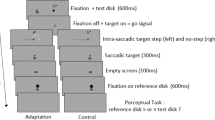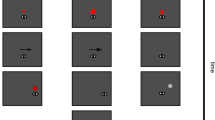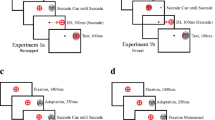Abstract
Saccadic adaptation maintains saccade accuracy and has been studied with the intrasaccadic target displacement procedure: displacing a target backwards (or forwards) during saccade execution gradually decreases (or increases) subsequent saccade amplitude. Adaptation has traditionally been studied with targeting saccades which bring the eyes onto a new object. Within-object saccades take the eye from one position in an object to another position in the same object and have been shown to resist the intrasaccadic target displacement procedure. The amplitude of within-object saccades depends on object size rather than position, and we therefore hypothesized that within-object saccades might adapt in response to an intrasaccadic change in object size. In separate sessions, we increased or decreased object size during within-object saccade execution. Results showed amplitude lengthening or shortening, respectively. Furthermore, within-object saccade adaptation seems to share several characteristics with targeting-saccade adaptation.




Similar content being viewed by others
Notes
When asked at the end of the experiment, only one subject reported having been aware of the change but could not decide whether it was a change in the size or in the position of the stimulus. Note that this subject’s adaptation/extinction profile was similar to that of the seven other subjects, who did not notice anything. This is an additional argument against adaptation being due to a strategy.
References
Abel L, Schmidt D, Dell’Osso L, Daroff R (1978) Saccadic system plasticity in humans. Ann Neurol 4:313–318
Alahyane N, Salemme R, Urquizar C, Cotti J, Guillaume A, Vercher J-L, Pélisson D (2007) Oculomotor plastiticy: are mechanisms of adaptation for reactive and voluntary saccades separate? Brain Res 135:107–121
Bach M, Bouis D, Fischer B (1983) An accurate and linear infrared oculometer. J Neurosci Methods 9:9–14
Bahcall DO, Kowler E (2000) The control of saccadic adaptation: implications for the scanning of natural visual scenes. Vis Res 4:2779–2796
Collins T, Doré-Mazars K (2006) Eye movement signals influence perception: evidence from the adaptation of reactive and volitional saccades. Vis Res 46:3659–3673
Collins T, Vergilino-Perez D, Beauvillain C, Doré-Mazars K (2007) Saccadic adaptation depends on object selection: evidence from between- and within-object saccadic eye movements. Brain Res 1152:95–105
Cotti J, Guillaume A, Alahyane N, Pélisson D, Vercher JL (2007) adaptation of voluntary saccades, but not of reactive saccades, transfers to hand pointing movements. J Neurophysiol 98:602–612
Deubel H (1995) Is saccadic adaptation context-specific? In: Findlay JM, Kentridge RW, Walker R (eds) Eye movement research: mechanism, processes and applications. Elsevier, Amsterdam
Deubel H, Wolf W, Hauske G (1986) Adaptative gain control of saccadic eye movements. Hum Neurobiol 5:245–253
Erkelens CJ, Hulleman J (1993) Selective adaptation of internally triggered saccades made to visual targets. Exp Brain Res 93:157–164
Findlay JM (1982) Global visual processing for saccadic eye movements. Vis Res 22:1033–1045
Fujita M, Amagai A, Minakawa F, Aoki M (2002) Selective and delay adaptation of human saccades. Cogn Brain Res 13:41–52
Herman JP, Harwood MR, Wallman J (2009) Saccade adaptation specific to visual context. J Neurophysiol 101:1713–1721
Hopp J, Fuchs A (2004) The characteristics and neuronal substrate of saccadic eye movement plasticity. Prog Neurobiol 72:27–53
Lavergne L, Vergilino-Perez D, Collins T, Orriols E, Doré-Mazars K (2008) The planning of a sequence of saccades in pro- and antisaccade tasks: Influence of visual integration time and concurrent motor processing. Brain Res 1245:82–95
Marotta JJ, Keith GP, Crawford JD (2005) Task-specific sensorimotor adaptation to reversing prisms. J Neurophysiol 93:1104–1110
McLaughlin S (1967) Parametric adjustment in saccadic eye movements. Percept Psychophys 2:359–362
Panouillères M, Weiss T, Urquizar C, Salemme R, Munoz DP, Pélisson D (2009) Behavioral evidence of separate adaptation mechanisms controlling saccade amplitude lengthening and shortening. J Neurophysiol 101:1550–1559
Pélisson D, Alahyane N, Panouillères M, Tilikete C (2010) Sensorimotor adaptation of saccadic eye movements. Neurosci Biobehav Rev doi:10.1016/j.neubiorev.2009.12.010
Straube A, Fuchs AF, Usher S, Robinson FR (1997) Characteristics of saccadic gain adaptation in rhesus macaques. J Neurophysiol 77:874–895
Vergilino D, Beauvillain C (2000) The planning of refixation saccades in reading. Vis Res 40:3527–3538
Vergilino D, Beauvillain C (2001) Reference frames in reading: evidence from visually and memory-guided saccades. Vis Res 41:3547–3557
Vergilino-Perez D, Findlay J (2006) Between-object and within-object saccade programming in a visual search task. Vis Res 46:2204–2216
Weigelt C, Bock O (2009) Adaptation of the precision grip orientation to a visual-haptic mismatch. Exp Brain Res (in press)
Acknowledgments
The authors wish to thank Sylvain Haupert and Eric Orriols for their assistance in developing the experimental software and the two anonymous reviewers for their helpful comments.
Author information
Authors and Affiliations
Corresponding author
Rights and permissions
About this article
Cite this article
Lavergne, L., Vergilino-Perez, D., Collins, T. et al. Adaptation of within-object saccades can be induced by changing stimulus size. Exp Brain Res 203, 773–780 (2010). https://doi.org/10.1007/s00221-010-2282-7
Received:
Accepted:
Published:
Issue Date:
DOI: https://doi.org/10.1007/s00221-010-2282-7




